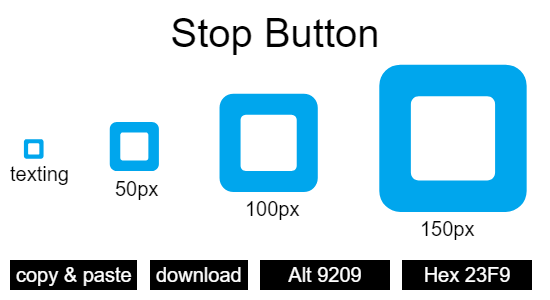"Stop Button" Emoji
How To Get the "Stop Button" Emoji
The ⏹ Stop Button emoji displays a solid square or rectangle, often seen on media or music players. It represents the action of stopping the playback or the complete termination of media content. This emoji can be used to indicate the end of an activity, the closure of a discussion, or the cessation of a process. It can also symbolize the need to halt or discontinue something. The stop button emoji is commonly employed in conversations about media, music, or any situation where the concept of stopping or concluding is relevant.Codes for the "Stop Button" Emoji
Click on a green box to copy its contents.Formal Name:
Stop Button
The symbol:
⏹
The Alt Code:
Alt 9209
The HTML Code:
⏹
HTML Entity:
none
CSS Code:
\23F9
Hex Code:
⏹
Unicode:
U+23F9

Create an Image of the Emoji
Use this widget to share, copy, or download the emoji as a resizeable .png image. (If you want to copy the emoji as a character (like a special font), use the table above.)Tip: If you need the image for WhatsApp, use the "Share" button and make sure the image is larger than 200x200, otherwise WhatsApp will resize it, making it blurry. (The bigger, the better.)
Click to resize the image.
Eight Ways to Insert the "Stop Button" Emoji
(Method 1) Copy and Paste the Emoji.
Click on the ⏹ emoji from the table above. Press the "Copy" button, and then paste the symbol into your document.(Method 2) Use the "Alt Code."
The Alt Code for ⏹ is Alt 9209. If you have a keyboard with a numeric pad, you can use this method. Simply hold down the Alt Key and type 9209. When you lift the Alt Key, ⏹ appears. ("Num Lock" must be on.)(Method 3) Use the HTML Decimal Code (for webpages).
| HTML Text | Output |
|---|---|
| ⏹ | ⏹ |
(Method 4) Use the HTML Entity Code (for webpages).
| HTML Text | Output |
|---|---|
| We do not have the HTML entity code for this emoji because there probably isn't one. If you think there is one, please tell us using the form at the bottom of the page. | none |
(Method 5) Use the CSS Code (for webpages).
| CSS and HTML Text | Output |
|---|---|
|
<style> span:after { content: "\23F9";} </style> <span>Symbol:</span> | Symbol: ⏹ |
(Method 6) Use the HTML Hex Code (for webpages).
| HTML Text | Output |
|---|---|
| ⏹ | ⏹ |
(Method 7) Use the Unicode (for various, e.g. Microsoft Office, JavaScript, Perl).
The Unicode for ⏹ is U+23F9. The important part is the hexadecimal number after the U+, which is used in various formats. For example, in Microsoft Office applications (e.g. Word, PowerPoint), do the following:| Type | Output |
|---|---|
| 23F9 [Hold down Alt] [Press x] | ⏹ (Note that you can omit any leading zeros.) |
| JavaScript Text | Output |
|---|---|
| let str = "\u23F9" document.write("My symbol: " + str) | My symbol: ⏹ |
(Method 8) Use the Hex Code for HTML 5 Canvas.
On the assumption that you already have your canvas and the context set up, use the Hex code in the format 0x23F9 to place the ⏹ emoji on your canvas. For example:| JavaScript Text |
|---|
|
const x = "0x"+"23F9" ctx.fillText(String.fromCodePoint(x), 5, 5); |
| Output |
⏹ |
Help Us Improve Cyber Definitions
- Do you disagree with something on this page?
- Did you spot a typo?
- Do you know a slang term that we've missed?

